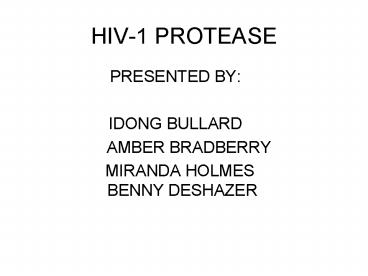HIV1 PROTEASE PowerPoint PPT Presentation
1 / 30
Title: HIV1 PROTEASE
1
HIV-1 PROTEASE
- PRESENTED BY
- IDONG BULLARD
- AMBER BRADBERRY
- MIRANDA HOLMES
BENNY DESHAZER
2
HIV-1
- HIV-1 is acellular organism
- Requires a human host to function
- HIV-1 gp120 (a glycoprotein ) binds to CD4
receptors - Conformational change of gp120 in addition with
other interactions enable the virus to enter into
host cell - Virus uses the metabolic machinery of the human
host to produce all its proteins and replicate
3
HIV-1
- HIV-1 produces precursor polyprotein that
requires cleavage - gal and gal-pol precursor protein
- HIV-1 also produces HIV-1 protease
- An enzyme
- The function of the protease is to cleave the
polyprotein into mature functional protein
4
Active site of HIV-1 protease
- Precursor protein binds to the active site of the
enzyme. - The enzyme cleaves off the precursor protein
- Cleavage result in mature and functional form of
the protein - Gag and Gag-Pol structural protein
- Only after the cleavage is the virus now mature
and capable of infecting new cells
5
Impact of HIV-1 protease
- AIDS is the final stage of HIV-1 infection
- According to CDC, at the end of 2007,
- 33.2 million living with HIV infection
- 7,500 new infection daily
- 2.5 million new infections yearly
- 2 million deaths from AIDS
- Only 3 million are receiving antiretroviral
treatment
6
Application of HIV-1 protease
- The activities of the enzyme has become a point
of interest especially for drug designers - Knowledge of these activities are being used to
design antiretroviral drugs. - Drugs inhibit the precursor polyprotein from
binding on the active site of the enzyme - Binding on the active site inhibit functional
Gag and Gag-Pol from being produced.
7
Drug Inhibitors
- 1. Indinavir
- 2. Saquinavir
- 3. Ritonavir
- 4. Nelfinavir
www.hyle.org/journal/issues/9-1/spector.htm
8
Structure
- PBD 4PHV
- 2 Identical Chains
- (A B)
- All Amino Acid
- 99 Amino Acid Residues per Chain
- Not Transmembrane
9
Secondary Structure
- From PELE
- 2 Alpha Helices
- 2 Beta Strands
- Alpha Helix
- PQITLWQRPLVTIKIGGQLKEALLDTGADDTVLEEMNLPGRWKPKMIGGI
GGFIKVRQYDQILIEICGHKAIGTVLVGPTPVNIIGRNLLTQIGCTLNF - Beta Strands
- PQITLWQRPLVTIKIGGQLKEALLDTGADDTVLEEMNLPGRWKPKMIGGI
GGFIKVRQYDQILIEICGHKAIGTVLVGPTPVNIIGRNLLTQIGCTLNF
10
Secondary Structure
- From Protein Explorer
- 2 Alpha Helices
- 4 Beta Strands
- 2 Strands and 1 Helix On Each Chain
11
Structural Motifs
- Family Retroviral Aspartyl Protease
- AAs 22 to 34 (ALLDTGADDTVLE)
- Myristyl
- Acylates by adding a myristate to a glycine
- PKC Phosphorylation Site
- Phosphorylates serine or theronine
- CK2 Phosphorylation Site
12
Ligand
- VAC An Inhibitor
- Residues Involved
- 8, 23, 25-32, 47-50, 80-82, and 86
- R, L, DTGADDTV, IGGI, TPV, G
13
Active Site
- Residues 25 to 32
- AA sequence
- DTGADDTV
- Contains 3 Aspartic Acid
14
Phylogeny Tree
15
Tree Analysis
- Excepted Results
- The HIV virus is close to the mammalian on the
branch - Unexcepted Results
- The HIV virus is close to the bacteria, E. coli
- The HIV virus is not close to other virus
16
Bacteria vs. Viruses
17
Alignments
- SIV vs HIV protease
- SIV (top) HIV Protease (middle)
- GKQTGKEREGSIRGSLQLPQFSLWNRPTTVVEIEGQKVEALLDTGADDTV
- ------------------PQFSLWKRPVVTAYIEGQPVEVLLDTGADDSI
- ....
. - SIV (top) HIV Protease (middle)
- IKDLDLKGNWKPQIIGGIGGSINVKQFFNCKVTIAGKTTHASVLVGPTPV
- VAGIELGNNYSPKIVGGIGGFINTLEYKNVEIEVLNKKVRATIMTGDTPI
- . .. . ....
- SIV (top) HIV Protease (middle)
- NIVGRNVLKKLGCTLNFPVSKVETVKVTLKPGTDGPKIKQWPLSKEKILA
- NIFGRNILTALGMSLNL---------------------------------
- ..
18
Alignments
- E. Coli vs. HIV protease
- E_Coli (top), HIV Protease (middle)
- PQITLWKRPLVTIRIGGQLKEALLDTGADDTVLEEMNLPGKWKPKMIGGI
- PQITLWQRPLVTIKIGGQLKEALLDTGADDTVLEEMNLPGRWKPKMIGGI
- E_Coli (top), HIV Protease (middle)
- GGFIKVRQYDQIPVEICGHKAIGTVLVGPTPVNIIGRNLLTQIGCTLNF
- GGFIKVRQYDQILIEICGHKAIGTVLVGPTPVNIIGRNLLTQIGCTLNF
19
Phylogeny
20
Phylogeny
21
Phylogeny
22
Phylogeny
23
HIV-1 Protease Inhibitors
- Competitive inhibitors
- Disruption of HIV-1 protease
- creates viral particles that stunt the growth of
the virus
24
Current PR Inhibitors Used
- 9 FDA-approved inhibitors available now in the
medical market - Lopinavor, nelfinvar, indivinar,
- Currently theres research into a new family of
inhibitors of HIV-1 protease - Metallacarborane compounds
- Vitality
- Ability of the protease to work after an
inhibitor is introduced to the system
25
Metallacarboranes
- The ion studied
- 3-cobalt bis(1,2-dicarbollide)- ion
- GB-18
- Salt extraction produced boron clusters that were
also tested - GB-21, GB-48, and GB-80
- GB-48 and GB-80
- Are compounds structurally similar to GB-18
26
Journal of Medicinal Chemistry 2008
Figure 1. (A) Vitalities of seven clinical
inhibitors and metallacarborane compounds with
the panel of PR mutants. (B) Structural formulas
of metallacarborane inhibitors used in this work.
All compounds were prepared as Na salts.
27
Conclusion
- Metallocarboranes
- Show the potential to be useful inhibitors of
HIV-1 protease - Potent
- Specific
- Selective
- Inhibition of wild-type and mutated forms of the
enzyme
28
References
- Biology Workbench PELE, RPSBLAST, PDBFinder,
ProSearch, TMAP, and GREASE - Celebrate Life World AIDS Day 2008 Internet.
Centers for Disease Control and Prevention (US)
cited 2008 November 28. Available from
http//www.cdc.gov/Features/WorldAIDSDay/ - Cn3D
- Entrez
29
References
- Jenwitheesuk E, Samudrala R. 2003. Improved
prediction of HIV-1 protease-inhibitor binding
energies by molecular dynamics simulations. BMC
Structural Biology.2003 32 - Kozisek, Milan et al. 2008. Inorganic Polyhedral
Metallacarborane Inhibitors of HIV Protease A
New Approach To Overcoming Antiviral Resistance.
Journal of Medicinal Chemistry. 51(15) 4839-4843.
30
References
- Protein Explorer
- The Molecular Aesthetics of Disease The
Relationship of AIDS to the Scientific
Imagination Internet. c2003. Tami I. Spector.
Cited 2006 November 21. Available from http//
www.hyle.org/journal/issues/9-1/spector.htm

